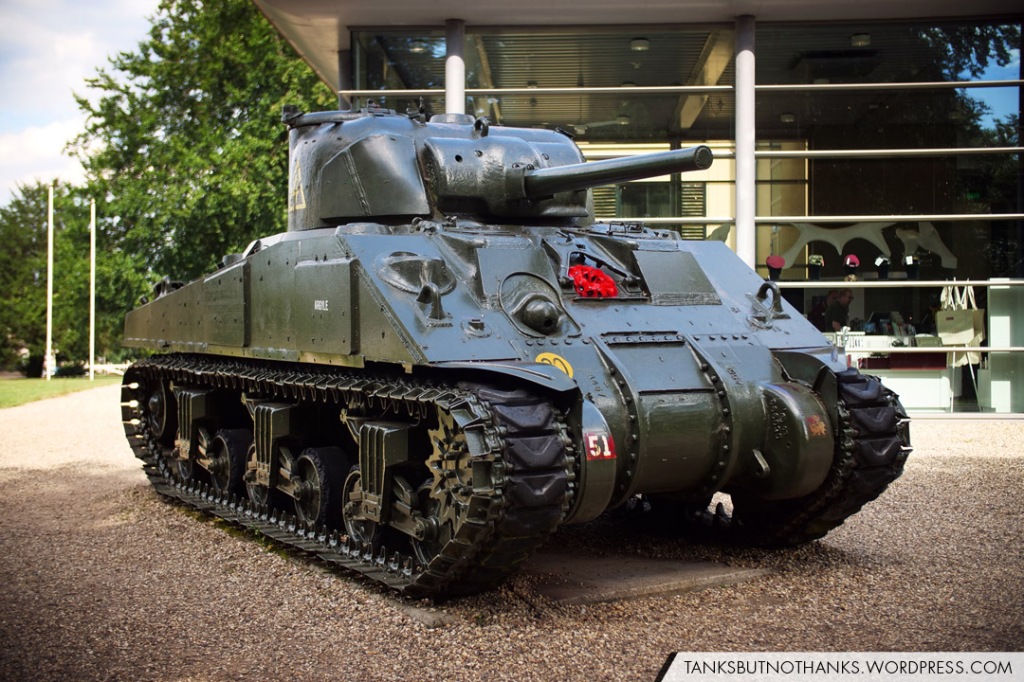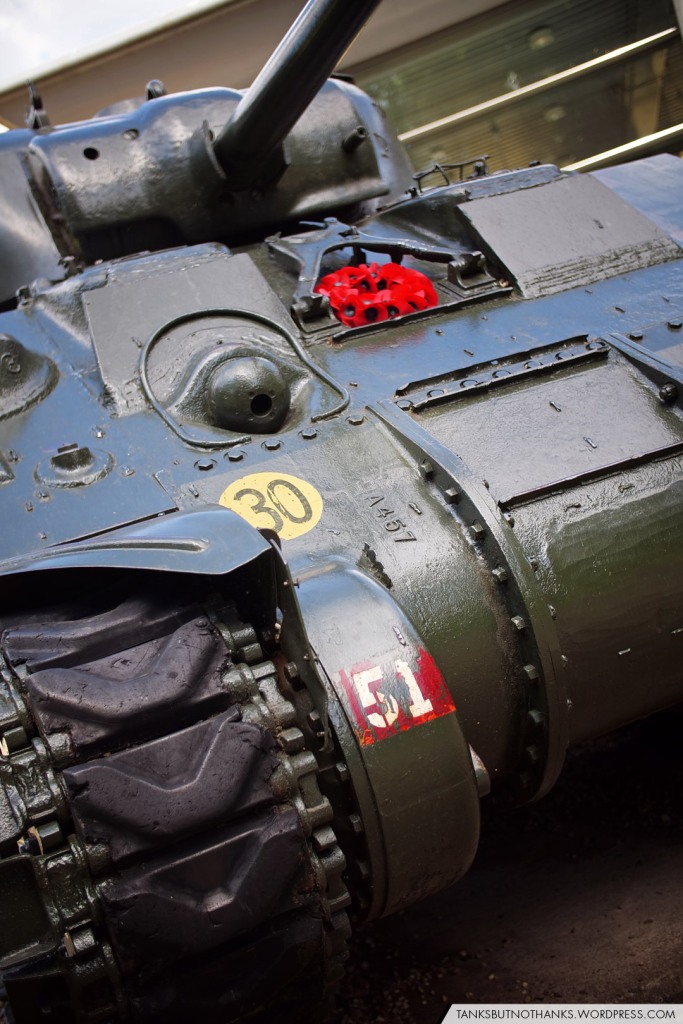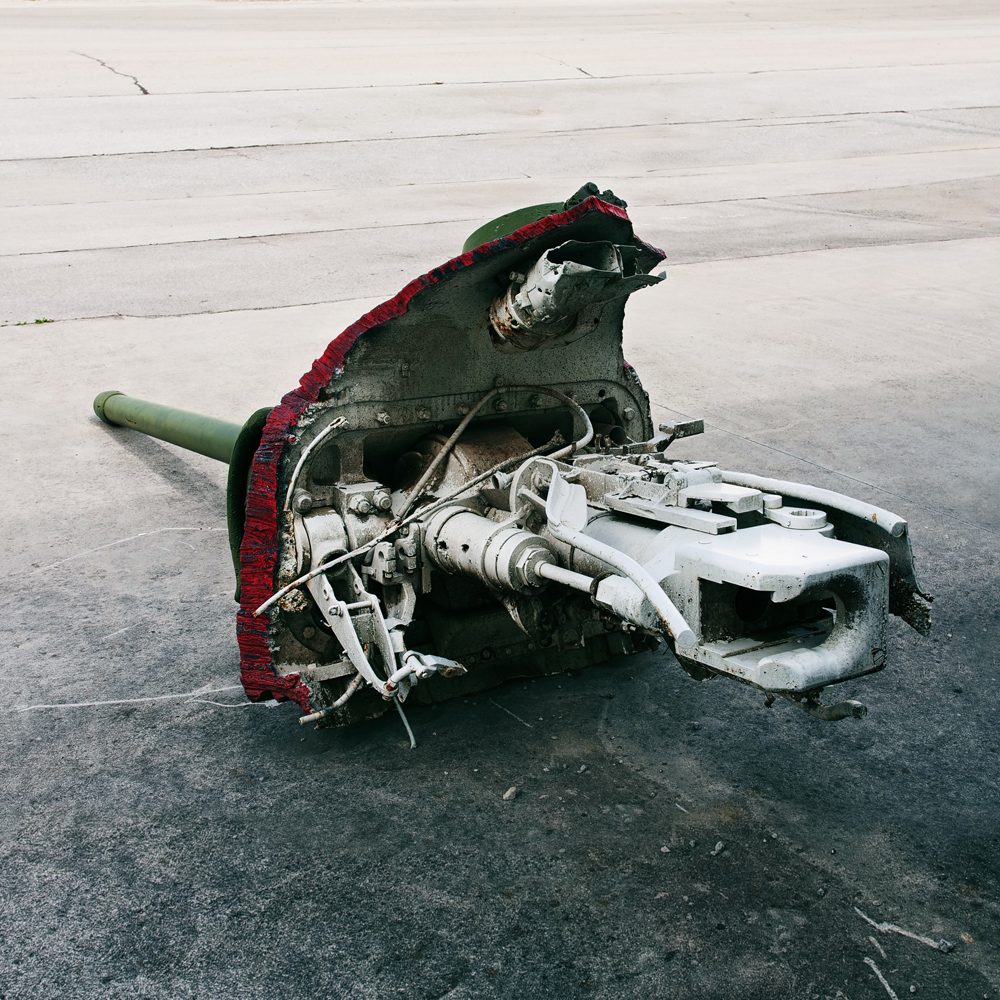Type: Medium Tank
Nation: USA
Period: World War 2
Location: Airborne Museum Hartenstein, Oosterbeek, Netherlands

From filler to killer
The shortage of radial engines for the M4 and M4A1 had led to the production of both the M4A2 with an improvised twin diesel engine as well as the Ford V8-powered M4A3. For the same reason a fifth Sherman variant was greenlit in early 1942. The engine of choice for the M4A4 was the massive liquid-cooled 30-cylinder Chrysler A57 Multibank, which had been developed for the M3A4 version of the Lee/Grant. The A57 consisted of five Chrysler straight-six flathead engines joined together in a star configuration around a central crankshaft. Rated at 425 hp, it was decently powerful, but its complexity and sheer size made it relatively difficult to maintain. The engine bay was so cramped that simply changing a spark plug required the engine to be removed from the vehicle. Even after receiving some simplifications it was found the least satisfactory of all five Sherman engines. As soon as the other powerplants would become available in sufficient numbers, the Multibank was to be discontinued. The US Army would not allow the M4A4 to be sent overseas. Just like the M4A2, the Americans only used the M4A4 for training purposes at home. Over 95 percent of all M4A4s were supplied to Great Britain under Lend-Lease. According to their designation system, the M4A4 was called “Sherman V” in British Service. The British admired this variant for its power and used it as the base vehicle for their 17-pounder VC Firefly conversions.

Supersize Sherman
The size of the improvised Chrysler engine made it necessary to lengthen the Sherman’s standard hull by eleven inches. Therefore the suspension bogies are spaced further apart and make the M4A4 relatively easy to identify from the side. The only other variant that utilised this elongated hull was the M4A6 with the Caterpillar multi-fuel radial engine. But, except for the early experimental version called M4E1, the M4A6 received a distinctive cast front, similar to the late-production M4 Composite. Chrysler built only 75 M4A6s between October 1943 and February 1944. They were only ever used for tests and none of these vehicles have survived. The M4A4 on the other hand was the second most produced Sherman variant. All 7,499 M4A4s were built from July 1942 until September 1943 by Chrysler at the Detroit Tank Arsenal in Warren, Michigan. By 1943 it was decided to reduce the number of variants while switching over to the improved second generation of the Sherman. The production effort was focussed on the M4A1(76)W, M4A2(76)W and the M4A3; the latter coming with three different armaments. The standard M4 was only continued as the M4(105) self-propelled assault gun. The M4A4 had fulfilled its role and was completely cancelled.

Borrowed plumes
This particular vehicle is located at the Airborne Museum Hartenstein, the historical building which served as the British 1st Airborne Division’s headquarters during the failed Operation Market Garden in September 1944. The tank was painted to resemble a tank of Lord Strathcona‘s Horse (Royal Canadians), a regiment in the 5th Canadian Armoured Division – the “Mighty Maroon Machine” who took part in Operation Cleanser, the much delayed liberation of the Netherlands in April 1945. These markings, however, are not original. There was an “Argyle” in said regiment in 1945, but that was a Sherman VC Firefly. The current “Argyle” shows no indication of a reconversion from Firefly to a 75 mm Sherman. As evident by old photographs, the vehicle’s original name had been “Argyll Roger”. However, it remains unclear by which unit and under which circumstances it was left at Hotel Hartenstein. “Argyll Roger” was covered in numerous weld marks where spare track links had been attached to the hull and turret – just like the ones on today’s “Argyle”. The Airborne Museum was first established in 1949 at the nearby Kasteel Doorwerth, where the tank was put on display. In 1977/1978 both the museum and the tank moved to the Hartenstein, where the official re-opening ceremony was led by none less than Major General Roy Urquhart, 1st Airborne’s commander during Market Garden.



5 responses to “M4A4 Sherman „Argyle“”
[…] tank, re-armed with the powerful 17-pounder anti-tank gun. In this case the base vehicle was an M4A4 which was powered by a Chrysler A57 30-cylinder multibank engine. The size of this engine required […]
LikeLiked by 1 person
[…] the M4, M4A1 and M4A2 was also switched to the second generation versions in early 1944, while the M4A4 and M4A6 were […]
LikeLike
[…] This spared the British the time, work and money to cut one in, as it had been necessary on the M4A4. Of the approximately 2,100 Firefly conversions, almost half were made from M4A4s (Sherman VC), […]
LikeLike
[…] M4A4 FL-10 was a not too creatively named up-armed Sherman version that combined the long M4A4 hull with the FL-10 oscillating turret taken from the AMX-13 light tank. This variant was designed […]
LikeLike
[…] 21th century. Starting in 1953, the Dutch Army received around 600 of them to replace their ageing Shermans and Rams. This vehicle is towing the awkward Monotrailer, which held over 900 litres of extra fuel […]
LikeLike